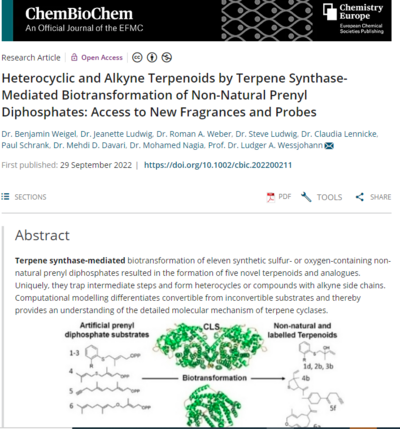Biocatalysis with terpene cyclases: New fragrances produced from non-natural compounds
IPB chemists have recently used two terpene cyclases as biocatalytic tools to investigate their suitability for the conversion of non-natural compounds. The enzymes studied, the limonene synthase from cannabis plant and the 5-epi-aristolochene synthase from tobacco, showed amazing flexibility for the eleven synthetic prenyl diphosphates offered to them as substrates. Numerous compounds were formed, including five novel terpenoids that also do not occur naturally, some with unusual structural properties such as heteroatoms and alkyne side chains. However, the Halle scientists were not only interested in the new compounds, whose structures they could elucidate, but also in shedding more light on the complex, hitherto poorly understood reaction mechanism of the terpene cyclases they used.
As is typical for terpene cyclases, both enzymes generated several complicated, mostly enantioselective, multicyclic structures starting from the consistently linear, non-chiral prenyl diphosphates. The transformation of the simply structured precursors involved multiple foldings and other complex reaction mechanisms. Using computer modeling, the Halle scientists established three critical chemical control factors that allowed them to predict the catalytic promiscuity of the enzymes and distinguish convertible from non-convertible substrates. As a result, they developed an initial proposal for a detailed three-step reaction mechanism first for the limonene synthase.
The enzymatic conversion of artificial substrates is a promising way to exploit the potential of biocatalytic syntheses, the IPB chemists are convinced. Especially in the case of terpene cyclases and synthases, there is still much need for research and understanding in this field. Last but not least, the products that emerge are interesting novel terpenoids that can be used in the future as biological probes or as fragrances.
Terpenoids represent one of the largest classes of secondary metabolites, with more than 80,000 compounds. Many of them are of great importance to their producers and to humans as beneficiaries. They act as attractants, toxins, repellents, or antibiotics. Volatile mono- and sesquiterpenes are the main components of floral fragrances and natural aromas. Therefore, these terpenes have significant commercial value as food additives and in the cosmetic and fragrance industries.
Original Publication:
Benjamin Weigel, Jeanette Ludwig, Roman A Weber, Steve Ludwig, Claudia Lennicke, Paul Schrank, Mehdi D Davari, Mohamed Nagia & Ludger A Wessjohann. Heterocyclic and Alkyne Terpenoids by Terpene Synthase-Mediated Biotransformation of Non-Natural Prenyl Diphosphates: Access to New Fragrances and Probes. Chembiochem 2022, doi: 10.1002/cbic.202200211


